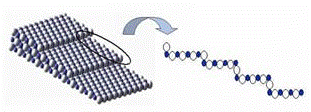Chemistry, Department of: Faculty Series

Marjorie A. Langell Publications
Document Type
Article
Date of this Version
October 1992
Abstract
Photoelectron spectroscopy with incident photons of 40–120 eV has been used to determine the valence-band structure of NiO(100) as the surface undergoes slow hydrogen reduction. Low pressure and moderate temperature conditions (1.3×10-2 Pa and 625 K) allow oxygen to be removed from the near-surface region with a minimal disruption in the NiO(100) substrate. Both NiO(100) ultraviolet photoemission spectroscopy (UPS) and low-energy electron-diffraction features persist at NiO(100) reduced surfaces throughout the reduction process. In addition, reduced nickel features slowly grow into the UP spectra, with the most intense peak found in the NiO band gap. Chemisorbed hydrogen, hydroxyls, and oxygen are also present. Initially, the reduction produces isolated reduced metal species. After ≊50% depletion of the near-surface oxygen, nucleation of extended Ni metal clusters is observed.


Comments
Published by American Physical Society. Phys. Rev. B 46, 9724 - 9731 (1992). http://link.aps.org/abstract/PRB/v46/p9724. Copyright © 1992 American Physical Society. Permission to use.